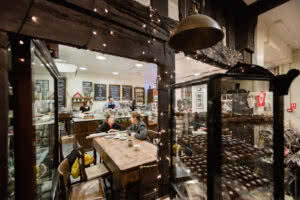Each year, tourists flock to the UK to discover the culture, see the sights, and make lasting memories. Whether they’re looking for an authentic British experience or something more adventurous, there are plenty of opportunities for you to make the most of this regular visitor flow – and attractions are a great place to start.
Fixed and permanent attractions can be a strong draw for international visitors, as they don’t need to plan their trips around specific dates. But where should you start as the creator? To help boost your success, we’ve rounded up the most important factors to consider when planning an attraction.
Who is attending your attraction?
A variety of potential international audiences exist, but it’s important to think about who specifically you want to target for your attraction and how. For those planning a trip in advance, especially families or big groups, booking tickets early may be a priority. Tap into this potential to secure ticket sales by offering early bird deals for those booking tickets ahead of time. Early bird tickets are typically set at a lower price, but you may also want to include an incentive. Why not think about offering priority queuing or free cloakroom usage to engage families looking for a low-hassle experience?
Listing the dates of upcoming attractions on Eventbrite is also a simple way to promote your event to international attendees and show them that your attraction is up and running. It can also be a useful way for you to gauge guest numbers. Although some of your attendees will indicate their attendance in advance, you may also want to keep tickets aside for solo travellers and those who want to purchase tickets at the door.
The Gen Z and Millenial generations are tech-savvy. Why not use this to your advantage by providing a QR code that they can scan to access an attraction guide or map? This cuts down the need for paper guides and makes translating content into other languages a lot easier. National Museum Wales’ pivot to digital is a fantastic example of how to keep digital trends at the forefront of your planning.
Where and when should you run your attraction?
When it comes to international visitors, it’s likely they’ll have a busy itinerary for their trip. Meanwhile, those in the area on business may have a limited time to see attractions outside of their working hours. Either way, it’s important to consider where and when you run your attraction to maximise attendance.
Hosting your attraction at an easily accessible location is a great way to increase the likelihood of people coming to see it. Think about placing your attraction near transport hubs, including national rail stations, tube stops, and even on well-connected bus routes.
It’s also worth thinking about running your attraction close to other popular tourist attractions. Conveniently, these are often close to good transport hubs, so you may also see footfall from tourists in the same area who are looking for another attraction to visit during the day.
To boost revenue and ensure guests linger at your attraction, think about potential food and drink offerings. If you can have an onsite option for food, that’s ideal – but you could also think about locating your event near established cafes and restaurants.
Location isn’t the only key factor – the opening times of your attraction come into play too. Families will likely want to plan their visit around children and do most of their sightseeing during the day, but this won’t be the case for everyone. Solo travellers might want to avoid crowds, while those on business trips may only have free time in the evenings. Think about keeping your attraction open late during peak travel seasons to cater for different audiences.
You could go further and market the attraction as more than just extended viewing hours. Why not consider making one of the evening slots adult-only and include a free drink token or a bar to make the event feel tailored to the demographic?
How to market international attractions
International event marketing can be slightly trickier than marketing to a local audience. Targeted ads are a great solution, and with Eventbrite Boost, targeting can be quick and easy. Once you’ve identified your audience, it’s important to research when and why particular groups may be visiting the area that your attraction is in. For example, is there a popular sporting event that brings in the same type of audience year after year? Or is there a business conference that people are attending?
Some of these patterns might be easier to predict, whereas others may be more time-sensitive. For example, if a sports team makes it to the final of a match and it’s due to be hosted in a nearby area, you could tweak some of your ads to reflect the language of the team and engage the fans directly.
Managing your attraction with international attendees in mind
International event management requires some thought, as you need to think about potential cultural differences, language accessibility, and even the potential to cause offence.
If your attraction already exists – for example, a museum exhibit or gallery – and it includes text-based information, you may want to think about how you can expand the range of languages on offer. If there isn’t enough space to display all the languages you want, consider providing brochures or multi-language audio guides instead.
If you’re concerned about controversial content or sensitive themes at your attraction, it’s worth flagging this on your website and reminding guests via email. For example, if you’re hosting an exhibition, you may want to provide guidance on what to expect in each room and an alternate route around the venue.
Creating a brand-new attraction gives you more scope to prevent issues that may arise from language or cultural barriers from the offset. You could focus on a purely visual attraction, for example, such as the Light Show Projection festival in Australia. The visual elements speak for themselves, and the creators don’t have to worry about accounting for language differences or dietary requirements.
Promote your attraction with Eventbrite Boost
Use Eventbrite Boost to help promote your attraction to a wider range of international audiences. Make the most of the smart targeting and insight tools available to discover the ideal attendee for your event. You can also streamline communication with your demographic through Eventbrite Boost’s targeted email and social media kit.






